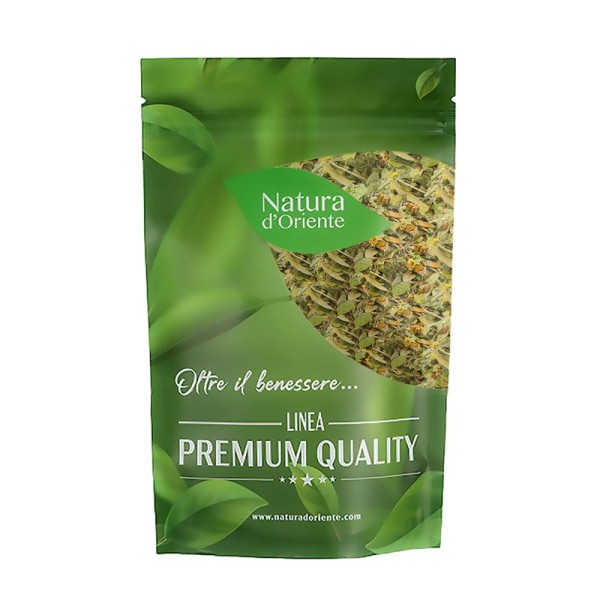The combination of herbs creates a sensation of lightness, aromaticity, and harmony. The sweet notes of licorice, anise, and elderberry balance the more intense herbaceous notes of senna, dodder, and bindweed. The floral and vegetal notes of other components contribute to a flavor profile that isn't too strong, for a pleasant effect with every sip.
Plants and Flowers
The herbal tea's components are derived from various parts of medicinal plants, primarily leaves. Most have been widespread in Europe for centuries, and today all the ingredients are available dried and ready for infusion.
Senna is a genus of plants in the legume family, Fabaceae. It is native to tropical climates, with a small number of species in temperate regions. The genus includes several species (over 300), including the Cassia Senna species and the Senna alexandrina, a small shrub (60–200 cm), with lanceolate leaves and yellow flowers.
Cuscuta is a genus of over 200 plant species in the Cuscutaceae family. These are yellow, orange, or red parasitic plants that grow throughout subtropical and tropical regions – they are rare in cold temperate climates.
Sambucus is a genus of plants in the Adoxaceae family. Various species are known, widespread in temperate and subtropical regions of the planet – particularly in the Northern Hemisphere. Elderberry grows best near residential areas, reaching a height of about 6 meters.
Licorice is the common name for Glycyrrhiza glabra, a plant in the Fabaceae family. Its root produces a sweet and aromatic flavor, known in confectionery. It is a perennial plant native to Western Asia, North Africa, and Southern Europe.
Common bindweed, with the scientific name Convolvulus arvensis, is part of the Convolvulaceae family. This climbing plant grows in hedges on terrain up to about 1,500 meters above sea level, reaching a height of 2 meters. It blooms between spring and summer, with highly fragrant flowers.
Cougar grass, or Agropyron repens, belongs to the Graminaceae family. It grows with a long rhizome and an erect, leafless stem, adapting to adverse climatic conditions and varying altitudes. Widespread throughout Europe, it is used primarily for its rhizome.
Spearmint (Mentha spicata) is an herb belonging to the Lamiaceae family. As a perennial plant, it is native to the Mediterranean and temperate Asia. Now widespread in many parts of the world, it is used as a flavoring in foods and beverages.
Helichrysum or Helichrysum Stoechas is a plant belonging to the Asteraceae family. As an aromatic herbaceous perennial, it prefers dry, rocky, and sandy soils. It can grow up to about 1.20 meters. It blooms from May to August, with small yellow flowers.
Rhamnus alpina or fallax is a shrubby plant of the Rhamnaceae family. Its shrub reaches a height of 3 to 4 meters, with green flowers that appear between May and August. It is found in forest clearings, rocks, and subalpine terrain.
Parietaria is a genus of flowering plants in the Urticaceae family. It is native to temperate and tropical regions, growing annually or perennially, up to about 60 cm tall, preferably on dry soils. It blooms from June to October.
Anise or Pimpinella anisum is a plant of the Apiaceae family. Native to the Mediterranean region and Asia, it is cultivated for its seeds, whose aroma and flavor are prized in cooking, distilling, and herbal medicine.
Orange refers to various citrus species in the Rutaceae family. The sweet orange primarily refers to Citrus × sinensis. It is considered a hybrid of Eastern origin, between pomelo and mandarin, and over the centuries, sweet orange varieties have emerged through mutations.
How to use herbs in herbal tea
The infusion is obtained by placing about 3-5 grams of the herbal mixture in a cup (250 ml) of water at 100°C.
Leave to steep for 8 to 10 minutes before drinking the herbal tea. Add honey or sugar, if desired.
Herbal Blend: Side Effects and Contraindications
It is advisable not to use the blend for long periods and to follow the recommended doses. Excessive or prolonged use of some ingredients, such as senna, may cause adverse effects.
Use is not recommended in cases of hypersensitivity to one or more ingredients, or in cases of specific gastrointestinal conditions. The herbal tea is not recommended for pregnant or breastfeeding women.









 No reward points for this product.
No reward points for this product.


